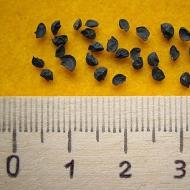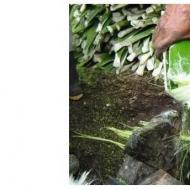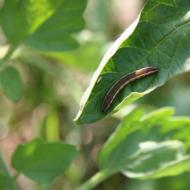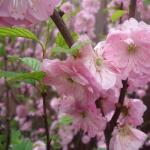
How to care for kumquat at home. Kumquat: growing at home from the stone
" Trees
Kumquat appeared on the shelves of Russian stores recently. It is a bright orange tropical fruit. It belongs to the citrus family. In terms of taste and useful qualities, the fruit of this amazing fruit is not inferior to any other citrus fruit..
The kumquat tree is evergreen. It reaches no more than two meters in height. And if pruning is done on time, then the tree will grow to the sides and look like a shrub. The height of a tree also depends on the size of the pot in which it is planted..
Having provided the necessary conditions, kumquats can be grown at home. Let's talk in more detail about the features of growing this exotic plant at home.
This fruit was first grown in China. Now it is grown in Japan, Southeast Asia, Europe and the USA.
 Kumquat - Chinese Mandarin
Kumquat - Chinese Mandarin For a long time it was not possible to grow kumquat in regions with a cool climate. Seeds were difficult to germinate, and if this happened, the cuttings died due to a weak root system. It was possible to achieve the reproduction of this plant only thanks to vaccinations. IN The branch of a kumquat tree has taken root on one of the frost-resistant citrus fruits - three-leafed poncirus. After that, the kumquat survived even at a temperature of -18℃.
It is worth noting that the taste of fruits grown in colder areas is not as sweet as in China.
Now this exotic fruit is grown in the Krasnodar Territory, in the Crimea, Ukraine.
In the Moscow region and Central Russia, kumquat can be grown at home or in a greenhouse. However, even in the south it is rarely planted in the ground, preferring "home care".
Requirements for a summer cottage
The suburban area where it is planned to grow Kumquat should be well lit.
It is necessary to protect the plant from direct sunlight on a hot summer day. It is important to provide diffused light. Otherwise, the direct rays of the sun can cause the tree to drop most of the foliage.
The kumquat tree loves moderate moisture around it.. To water this plant correctly, it is recommended to install an automatic watering system at their summer cottage. It should be remembered that the plant may die if it is flooded with water.
 Kumquat is a sun loving plant.
Kumquat is a sun loving plant. If the air temperature is low or moderate, it is recommended to water the plant every 2-3 days, or less often. In hot weather (+20-25°C) the tree should be watered every day.
From large temperature changes, the tree can shed its leaves. Therefore, it is necessary to ensure the conditions in the summer cottage in such a way as to avoid temperature fluctuations.
The tree will feel great if it is watered with water heated in the sun. To do this, you can collect water in an iron barrel, let it stand and warm up in the sun. Then use it to water the plants.
As for the soil for planting this tree, you can purchase soil intended for growing citrus fruits. Also you can prepare a special ground yourself. It is necessary to mix soddy soil, garden fertile soil, rotted manure, or leaf humus and sand.
Kumquats can be grown from seed. To do this, choose the most ripe fruit. The seeds are extracted from it. And soak them in any growth stimulator. Plant seeds to a depth of 1.5-2 cm in pots up to 8 cm in diameter.. The pot is covered with plastic wrap and left in a warm place. The first shoots can be expected 35-40 days after planting.
And this fruit is propagated by the following methods:
- With the help of vaccinations
- cuttings
- layering
Experienced citrus growers prefer to propagate it by cuttings or layering.
The most favorable time for propagation of kumquat by cuttings is April. A tree planted at this time of the year will take root better and get stronger faster.

Cuttings for planting must be prepared before winter. They leave at least three kidneys. Cut the cuttings 0.5 cm below the last kidney perpendicularly. The upper cut is made obliquely 1 cm higher from the kidney. In order for the cutting to take root, it is planted in a pre-prepared soil for citrus fruits, to a depth of 1.5-2 cm. and covered with a glass jar. It is important to provide the future tree with optimal humidity and sufficient watering.
The spring season is also chosen for tree propagation by layering.. To do this, take annual shoots 20 cm long and 0.5 cm thick. At a height of 10 cm, two cuts are made on the shoot bark every 1 cm. The bark is removed and the leaves are removed at a height of 5 cm. A plastic bag with earth is tied to this section of the shoot.
In order for the layering to take root faster, the soil must be constantly moistened.
Features of cultivation and care
The kumquat tree needs to be constantly watered and sprayed with warm settled water. If this is not done, the plant may become ill or die from various pests.
In order for the kumquat to grow evenly, gardeners turn the pot with a tree around its axis by 10 degrees every 8-9 days.
In the summer season, the tree is kept in partial shade. And in winter, on gloomy days, additional lighting is required.
It is necessary to fertilize the tree 2-3 times a month in the spring, summer and autumn seasons.. In the last months of autumn, as well as in winter, it is necessary to fertilize no more than once a month. An aqueous solution of mineral fertilizers is used as a fertilizer. Prepare it as follows: in 1 l. water dissolve 2-3 gr. ammonium nitrate, 1-2 gr. potassium salt and 4-6 simple superphosphate.
It is also useful to fertilize the tree with a solution of wood ash.

Repotting a Kumquat tree is recommended every 3 years.. This must be done at the end of February, or in March. It is important to transplant very carefully. It is required to save a whole clod of earth, braided with roots. The drainage at the new tree planting site needs to be updated.
When transplanting, the tree should not be planted deep. After transplantation, it is recommended to spray it and pour it with a weak solution of potassium permanganate.
Trimming Rules
In the spring, when the crown of the plant is actively forming, it is necessary to prune the tree. The growth of the tree should be uniform on all sides. Pruning should be done when new shoots have appeared on it. That is, the tree must be in the active growth phase. It is important to trim only the stiff part. Only in this case the tree slows down its growth and throws out side shoots.

After pruning, dormant buds are activated, forming shoots. Future shoots must be tied up so that the bush has a fan-shaped shape. Wounds must be treated with garden pitch. This is done in order to heal the wounds faster, as well as to prevent infection. A year after pruning, the tree will acquire an almost perfect crown.
Enemies of this plant
The most famous of them:
- spider mite
- Shchitovka
If white dots appear on the underside of the leaves, and also if the leaves are twisted and entangled in a white cobweb, this is signs of a spider mite attack.
To combat it, take a tablespoon of tobacco dust, pour a glass of hot water and after 6 days add 10 g. laundry soap. The resulting solution is treated with a tree 3 times with an interval of 6 days.
Before proceeding with the processing of wood with the resulting mixture, it is necessary to cover the ground with a film. Do not allow the mixture to enter the ground. Carefully treat the leaves and branches of the affected tree with a cotton swab. It is necessary to wash off the applied solution after 3-4 hours under the shower. After 6 days, the procedure must be repeated.
What varieties are grown at home
There are some types of trees that can be grown at home:
- - one of the most common types. It differs from other varieties in sweet fruits resembling olives.
- Kumquat Japonika (this variety is also called Kumquat Meiwa)- the fruit is yellow-orange in color, very similar to a lemon. Shrub with oval leaves and short thorns. This variety is frost resistant. It is grown in the south of Russia in open ground.
- - the fruits are very tasty and sweet.
There are also many kumquat hybrids. Below are some of them:
- limequat- Derived from lime and kumquat
- orangequat- Derived from orange and kumquat
- lemonquat- lemon crossed with kumquat
- Calamondin- from mandarin and kumquat
Conclusion
Kumquat is a beautiful plant that produces unusual fruits of small size. Differs from citrus fruits in that they are eaten with the peel.. Growing it at home is quite difficult, because it requires a lot of attention and is extremely whimsical. But those lucky ones who managed to provide the necessary conditions and care for this tree know for sure that it was worth it.
Kumquat is considered a native of China, brought to the European and American continents in the nineteenth century. Now it grows in many countries and is often called the Japanese orange.
The evergreen kumquat citrus tree, which many flower growers dream of growing at home, attracts attention with its exotic appearance. It belongs to the genus Fortunella and is called by the Japanese kinkan, that is, "golden orange", and by the Chinese - kumquat, which means "golden apple". In stores, the fruits of this tree can also be found under the name "Chinese mandarin".
Outwardly, it looks like a miniature orange, and it tastes like a tangerine, only with an edible peel.
general description
Kumquat, planting and care at home for which is not too complicated, enjoys well-deserved popularity among amateur flower growers.

The woody kumquat shrub is distinguished by its compact miniature size with a well-developed crown and medium-sized leaves due to dense tillering. The plant blooms with pinkish white fragrant flowers, giving abundant fruiting.
The skin of the kumquat fruit is quite sweet, and the flesh has a sour taste. Therefore, it is recommended to eat them whole at once, so that the taste mixes and balances. It is easiest to grow this crop by grafting onto another citrus, such as a lemon, or by cuttings. When propagated by seeds, fruiting occurs only after ten years, so growing kumquat from seeds at home is quite laborious, but interesting, requiring care and patience from the grower.
Culture varieties
Kumquat lends itself well to crossing with other citrus fruits, so there are its well-known interspecific and intergeneric hybrids:
- limequat (lime with kumquat);
- calamondin (kumquat with tangerine);
- orangequat (tangerine with kumquat) and others.
Due to its small stature, the plant is often used to form kumquat bonsai.
Growing at home this room culture is suitable for all varieties, as well as for its hybrid with tangerine sour. But most often, amateur growers use the more resistant varieties Nagami and Marumi with orange fruits similar to olives, Meiwa with round sweet berries and Indio Mandarinquat with large bell-shaped orange fruits.
Growth and flowering of kumquat
In a room near the trees of this culture, growth begins in late April-early May, and, depending on the conditions of detention, lasts from thirty to fifty days. An adult plant has one growth period, and a young one has two (with an average growth of six to ten centimeters). In a room, a one and a half meter kumquat can grow, growing at home for this reason, for full development, should be done in a fairly large container.

The flowering of the plant begins in mid-summer and continues until the end of August. After the first wave of flowering ends, after a couple of weeks, as a rule, the second begins.
Bisexual white small flowers of the plant, collected in a brush, allow it to cross-pollinate, but the process of self-pollination can also occur. Flowering culture for good fruiting must be regulated. Thirty-gram fruits of bright orange or golden yellow, round or oval, up to five centimeters in length and up to two centimeters in size, appear from the beginning to the end of winter, for almost three months.
Kumquat: growing at home, care
The plant is demanding on lighting and moisture. For good development in the summer, he is given a place with diffused sunlight, it is better if it is outdoors. In winter, the kumquat must be kept on the south side at a temperature of about fifteen degrees Celsius in a bright room. If it is not possible to provide a decrease in temperature, then for the good development of the tree it is necessary to increase the length of daylight hours.

Watering the culture must be carried out only with warm water, and in winter it should be moderate, and in summer - plentiful, but without drying out and waterlogging of the earth. From the use of cold water for irrigation, the plant sheds foliage.
In hot weather and during the heating season, it is necessary to regularly spray the kumquat with warm water or wipe the leaves with a damp cloth.
In order for the fruiting process of a plant such as kumquat to proceed well on the windowsill, the growing conditions necessarily require systematic feeding, maintaining the ambient temperature and proper crown formation. For the latter, in the spring, after pinching, all side shoots are pruned, while leaving three to four young shoots on each side branch.
Transplant and soil for the plant
At the end of winter - the beginning of spring, before the shoots begin to grow, the fruit-bearing kumquat is transplanted. Growing at home requires doing it once every two to three years.
The transplantation process itself is carried out by transshipment, without damaging the earthen coma and roots. In this case, it is necessary to completely change the drainage. The gaps between the lump and the walls of the new pot are filled and compacted with fresh soil. Then the tree is abundantly moistened and placed for a couple of weeks in a warm, dark room. At this time, it is necessary to regularly spray the crown with warm water.
For planting kumquat, a soil mixture containing the following components is best suited: medium-grained sand - half; leaf humus or rotted manure - one part; fertile garden land - one part; soddy soil - two parts.
For younger plants, a soil mixture is needed that is lighter in composition, and for fruit-bearing trees, the proportion of garden or sod land is increased by one and a half to two times.
Kumquat: growing at home from the stone
Despite the complexity and duration of the process, many flower growers still try to grow kumquats from seeds.

This process can be described step by step as follows:
- Seed collection. Seeds must be collected only from fresh and well-ripened fruits. After removing the bones, they are washed and slightly dried.
- Preparing for landing. Before planting, the seeds are soaked in any antiseptic stimulant. High flower pots up to eight centimeters in diameter are prepared for seedlings, and they are also disinfected. Expanded clay drainage is laid at the bottom.
- Prepare a mixture of river sand and garden soil in equal proportions or buy a soil mixture for citrus fruits. The earth prepared by oneself must be calcined in the oven.
- Planting seeds. The seeds are planted in moist soil with a depth of 2 cm, three pieces in a pot, covered with a film and put in heat (+20 ° C).
- Pick. Shoots will appear in about a month and a half. After four true leaves have sprung up, the seedlings dive into separate pots.
Despite the fact that Nagami kumquat gives the best seed germination, growing it and other varieties at home should be done in several pots, since not all seeds will sprout.
Fertilizers for kumquat
The schedule for applying fertilizers and their amount depends on many factors: on the composition of the land, on the age of the tree and its condition, on the size of the planting capacity, and so on.
If a large plant grows in a small pot, then it needs to be fertilized more often.
Fertilizing plants are fertilized from March to September three times a month, during the dormant period - no more than once. The composition of the mineral solution for fertilizer should be as follows: ammonium nitrate - 2.5 g; potassium salt or potassium chloride - 1.5 g; simple superphosphate - 5 g; water - 1 l.
It will also be useful for the plant to feed with wood ash diluted in water.
Use in cooking
For consumption, the skin of the berries is not cut off. Kumquat fruits are amazingly tasty, not only fresh. Useful and tasty are marmalade, candied fruits, jams and preserves cooked from them. Kumquat berries add amazing flavor to yoghurt and cottage cheese desserts, as well as refreshing sweet and sour juice made from them.

Also, the fruits of this plant are used as seasonings for salads, sauces for animal and poultry meat, fish, and also as an ingredient in fruit salads. Often these beautiful fresh berries decorate cold and hot dishes, sandwich skewers, cocktail glasses on festive tables.
Such fruits are also good as a snack for strong alcoholic drinks: cognac, whiskey, vodka and others. In martini cocktails, kumquat successfully replaces orange juice, and in gin and tonic - lemon.
Medicinal properties
Useful and healing properties of kumquat are due to the high content of various substances and essential oils in its peel. The fruits effectively help in the treatment of colds and respiratory diseases, as well as skin lesions with fungal infections (thanks to furakumarin).

The fruits of this plant have a calming effect, normalize digestion, help overcome apathy and depression. Berries contain a large amount of potassium and calcium, vitamins A and C, and have an anti-alcohol effect.
Citrus fruits have always been popular with lovers of indoor floriculture. In recent years, the range of such plants has expanded. Among the new products is the kumquat. Growing at home this yet unfamiliar citrus is often accompanied by questions. But they have clear answers that allow you to easily keep the plant in an apartment or winter garden.
KUMQUAT
A person who sees a kumquat for the first time will mistake it for an unusual variety of mandarin or dwarf orange. And even experienced gardeners, faced with a plant that has no fruits, can mistake it for a tangerine. The reason is obvious - these plants are close relatives belonging to the same family.
Kumquat is cultivated as a food, ornamental and essential oil plant in many countries. Although the birthplace of the plant is Southeast Asia, its current range is much wider. In addition to China, Japan, India, Vietnam, kumquat is grown in the Middle East, southern Europe and North America.
Photo www.hortus.ru: Kumquat fruits ripened in the Botanical Garden of Moscow State University "Pharmaceutical Garden"
Systematics and names
One of the most common names for the plant and its fruits, kumquat, is directly related to the mandarin. These are two Chinese words “kam kuat” distorted by the Spaniards, which translate as “golden tangerine”.
The Japanese name "kinkan" is less common, almost never used by Europeans.
Another synonymous name is "fortunella". It comes from the scientific Latin Fortunella and is mainly used in Western Europe.
Kumquat belongs to the department of Angiosperms (Flowering) plants, the Dicotyledonous class, the Rutovye family, like all representatives of citrus fruits.
The first scientific description of the kumquat belongs to the Portuguese missionary and scientist Juan de Loureira, who gave names to many plants in Southeast Asia.
The plant owes its scientific name "fortunella" to the American botanist Walter Swingle, who specialized in the study of citrus plants.
Scientists are currently isolating six types of kumquat
. Several varieties of this plant are also common, one of them with variegated leaves.

At home, most often we grow "oval kumquat" - Fortunella margarita
(Fortunella margarita) with elongated oval fruits, aka Nagami kumquat.
"Round Kumquat" Fortunella japonica
(Japanese Fortunella, or Marumi kumquat) with round fruits in room culture is less common.
Fortunella hindsii
(Hong Kong kumquat, or Golden Bean kumquat) is a slow growing citrus. Even an adult plant does not grow above a meter. This mini kumquat is often used to create bonsai.
View Fortunella obovata
(Fukushi kumquat) common in pot culture in China and Japan. A dwarf plant is tolerant of indoor lighting, has obovate fruits.
Fortunella polyandra
(Malay kumquat) is used for decorative purposes. In a pot culture, it grows up to a meter, although in its natural environment its height can reach 5 m.
Relatively large round or oval pitted fruits in the species Fortunella crassifolia
(Meiwa kumquat). It is the sweetest kumquat cultivated as a fruit plant. Formed as a result of natural hybridization in Japan.
Breeders have created many hybrids of kumquat with other plants from the citrus group, for example:
calamondin
- tangerine + fortunella margarita (outwardly similar to kumquat, and the fruits are like miniature tangerines with a thin crust);
limequat - lime + kumquat;
citrumquat - trifoliata + kumquat;
orangequat - a variety of mandarin (unshiu) + kumquat (with bright orange pear-shaped fruits);
lemonquat - lemon + kumquat.
GROWING KUMQUAT IN CLOSED GROUND
At home, indoors, the kumquat is grown mainly as an ornamental plant. Kumquat is valued not only for its bright fruits, which look spectacular against the backdrop of shiny dark green foliage. During the flowering period, the tree is completely strewn with snow-white flowers, which, moreover, have a pleasant aroma.
Greenhouses and winter gardens
 Growing Fortunella in greenhouses, greenhouses and winter gardens is much easier than in an apartment. This is due to several factors:
Growing Fortunella in greenhouses, greenhouses and winter gardens is much easier than in an apartment. This is due to several factors:
transparent ceilings and walls of a winter garden or greenhouse allow the plant to receive much more sunlight, which is very important for the kumquat, whose homeland is the tropics;
in greenhouses and greenhouses, as a rule, high humidity is maintained;
in greenhouses and greenhouses, various lamps are provided to extend daylight hours in autumn and winter;
in winter gardens and greenhouses, kumquat will not grow alone, but in a group with other plants, this will help maintain the desired air humidity in case of its lack (for example, in summer);
in the autumn-winter period, in most greenhouses and greenhouses, the temperature is reduced - a period of relative rest is needed for plants in the tropics and subtropics, including kumquat;
in the event of a plant disease or damage by pests in a greenhouse, it can be treated with strong chemicals, which cannot be done in an apartment.
Photo www.hortus.ru: In summer, the kumquat from the greenhouse is moved to the garden of the Apothecary Garden ▲
Growing in an apartment
Kumquat can be attributed to plants with an average complexity of care. With due attention, he will delight with beautiful flowers and bright fruits. If at home the necessary conditions are not met, then the kumquat will not lay flower buds, drop leaves or stop growing. But this does not mean that the plant will die. Even a tree completely devoid of leaves can be restored to beauty.
After the fruit has fallen off, the kumquat can be trimmed. This will form the crown and stimulate the development of dormant buds.
In the summer, kumquat can be taken out to a balcony or terrace, but the plant must be placed in a place protected from drafts.
Temperature
Kumquat refers to seasonal plants that need a dormant period for normal development. Therefore, the optimal summer temperatures for kumquat are 24-30 degrees, in winter - 14 - 17 degrees. Then, subject to sufficient illumination, fruit ripening will occur in winter. Wintering at +10 degrees and a bright location contributes to the spring-summer ripening of fruits.
Lighting 
Kumquat needs good lighting, with a lack of sunlight, its leaves become pale green, the shoots are thin and elongated. Flower buds are not laid, respectively, the plant does not bloom and does not bear fruit. In the summer, the kumquat should be covered from daytime direct sunlight. During this period, bright diffused light will be optimal. Morning and evening direct rays are allowed. Otherwise, the plant gets burns on the leaves.
The kumquat is not afraid of the winter sun, on the contrary, it needs it. From mid-autumn to early spring, the plant should be illuminated with a lamp, lengthening daylight hours.
Photo: Blooming Fortunella
substrate
Like other members of the citrus subfamily, the kumquat loves light substrates rich in organic matter. To make the soil water and breathable, perlite or river sand is added to it. Soddy soil or peat, humus or compost, leaf soil in the ratio 1:1:1 are used as the main components. The amount of perlite depends on the age of the plant: a small kumquat needs more perlite (part of the sand will be 1). An adult large plant needs 0.5 parts of sand (perlite).
Humidity and watering
Kumquat likes moderate watering in spring and autumn, and light watering in winter when temperatures drop.
In the hot summer period, the plant needs to be watered more strongly, once every 2-3 days, as the soil dries up. Kumquat should be watered in the morning with water at room temperature.
To avoid stagnation of water in the soil, drainage is laid on the bottom of the pot - expanded clay, shards, small stones.
Fortunella prefers to grow in high humidity. If the air is too dry, the tree will shed its leaves. This usually happens when the heating is turned on in the apartment. To avoid this, you need to regularly spray the plant, and once a week you can arrange a kumquat shower in the bathroom. This will serve as a preventive measure against the development spider mite
, which breeds at high temperature and dry air.
If in winter the kumquat is kept at a low temperature, then it must be sprayed carefully, and the shower should be excluded. High humidity and heavy watering with a decrease in temperature can lead to fungal infections.
To maintain air humidity next to the plant, you can put a container of water, or place the kumquat in a group with other plants.
Photo: Growing kumquat at home. Summer content
fertilizers
It is necessary to fertilize kumquat only during the period of its growth and development; in winter, the plant is not fed. If a liquid foliar fertilizer is used for fertilizer, then when spraying it, you need to make sure that its drops do not fall on the flowers.
If fertilizer is applied to the soil, then the substrate must be wet.
It is best to use two types of fertilizers: organic and complex inorganic (containing potassium, phosphorus, nitrogen).
Fertilizers need to be applied 1-2 times a week in the summer, and 1-2 times a month in spring and autumn.


Photo ▲: The flexible branches of the fruited kumquat are supported by a net, and the blinds protect the plant from direct sun.
Photo: Growing kumquat in a standard form at home
The compact and low Kumquat tree is very popular with flower growers all over the world. The plant belongs to citrus, comes from China and has several names. At home, it is called "golden orange", in Japan, kinkan or "golden apple".
In Europe, citrus became widespread after 1846, when the famous English botanist, traveler and collector Robert Fortune brought a small tree from China to the Royal Botanic Gardens, Kew. In his honor, a new genus of citrus fruits, Fortunella, was named, to which the plant belongs.
Some of the most popular varieties that are often found in the home are Nagami Kumquat and Rotondo, as well as the Fukushi variety with large, juicy and tasty fruits, and the Hong Kong kumquat with inedible and very small fruits.
In cultural floriculture, you can find natural and artificial citrus kinkan hybrids, and one of them is the well-known Calamondin, obtained by crossing with mandarin.
At home, the kumquat grows up to one and a half meters. The plant has a dense branched crown and small dark green shiny leaves. The stems are usually devoid of thorns or they are not very large.
The period of fragrant flowering falls on July-August. As a rule, flowering lasts 5-7 days, but there are also re-blooming specimens on which flowers bloom again after 2-3 weeks. After flowering, fruits are tied on the tree, which ripen in December-January.
If the plant is purchased for edible fruits, then flowering must be regulated, since a large number of flowers weakens the tree and reduces the number of quality ovaries.
In turn, if there are a lot of ovaries, then they also need to be cut in order to get beautiful full-fledged fruits. Kumquat fruits are small, golden yellow or orange, oval or pear shaped, rich in valuable nutrients.
Features of care
Kumquat, like all citrus fruits, is a fairly difficult crop to grow. For good growth and flowering, he needs to create comfortable conditions. But the result of increased care and attention will be a magnificent exotic tree that will delight you with tropical fruits.
Young plants have two growth periods, and adults have one. It begins in late April or early May and lasts approximately 30-50 days. During this time, the growth of the tree is 6-10 cm.
Lighting
Citrus is a sun-loving crop, so the optimal location is the south side. However, in the summer, the kinkan needs to create conditions for bright diffused lighting.
But in winter, direct sunlight is needed, and with a lack of lighting, it is advisable to use a fitolamp. The warmer the room, the more light the plant needs and vice versa.

How to water kumquat at home
In the spring-summer period, the golden orange requires abundant watering with warm water; the plant reacts to cold water by dropping foliage. The soil should always be slightly damp, but not wet, so be sure to pour out excess water in the pan after 30 minutes.
In winter, limit watering, but do not let the earthy coma dry out. You can determine the time of the procedure by the soil - the top layer should dry by 4 cm, this is about once a week. Water with soft settled or artesian water.
A tropical tree needs high humidity, especially at high temperatures. You can increase the humidity using a spray bottle or a bowl filled with water with wet expanded clay, which is placed next to the pot. An adult plant responds gratefully to a warm shower and rubbing the leaves with a damp cloth.
Temperature regime
The optimum summer temperature is 25-30 ̊С. In winter, it must be lowered to 12-16 ̊С. A cool dormant period promotes the formation of flower buds and abundant fruiting in the next season. In the absence of a cool period, the kumquat reacts by losing foliage in the future.
In warm weather, it is useful to take a tree out into the open air, but at the same time protect it from drafts, too high temperatures during the day and from hypothermia at night. Sudden changes in temperature adversely affect the plant, weakening it, and can lead to death.

Transfer
Young specimens need to be transplanted 2 times a year in spring and at the end of summer after flowering. Middle-aged trees are transplanted every 1-2 years, but an adult kumquat is transplanted no more than once every 2-3 years. The need for transplantation is evidenced by the roots that peek out of the drainage holes.
The procedure is carried out at the end of February or at the beginning of March by transshipment into a slightly larger pot (by 2-3 cm), at the bottom of which a high drainage layer of expanded clay is laid out, about a quarter of the volume of the pot. The trunk of the tree is deepened to the same level, not higher! Otherwise, citrus can get sick and even die.
The space around the earthen coma is covered with new soil and tamped down. After the procedure, the plant is well watered for several days and placed in a warm place with diffused light. During this period, it is also useful to spray the crown of the tree with warm water every day.
For transplanting, use a universal garden soil with the addition of sand (perlite) and pieces of pine bark in a ratio of 2: 1: 1.

top dressing
There are several factors to consider when applying fertilizers. At different times of the year, kinkan needs different types of nutrients and different frequency of application.
From March to September, top dressing is applied once every two weeks, from mid-March once every one to two months is enough. During the period of growing green mass, fertilizing with a large amount of nitrogen is used; in the budding and flowering phase, phosphorus-potassium fertilizer is used. In autumn, only potassium is added.
Sick and weakened plants, immediately after transplantation and during a winter drop in temperature, are not fed, as the procedure will either be ineffective or damage the citrus.
reproduction
You can grow a kumquat at home from a seed, using cuttings, banding or grafting shoots. The last two methods are quite laborious and are suitable for experienced flower growers.
Fresh seeds are sown in a pot with a mixture of soil with the addition of coarse sand. Before planting, the seeds are soaked in water with the addition of a hormone for better rooting. The seed pot is covered with a film to create greenhouse conditions. The soil should be moderately moist at all times, but not wet.
 Growing kumquat from the bone
Growing kumquat from the bone The first sprouts appear after a month, and sometimes after 2 months. At the stage of 4-5 leaves, they dive and plant them in separate pots with a part of an earthy coma, since the roots are fragile and the seedlings painfully endure transplantation. When the tree grows a little, then pinch the top.
Kumquat grown from seed does not retain the varietal characteristics of the mother plant and blooms only after 10-15 years. A more productive method that guarantees fruiting is propagation of kumquat by cuttings. The best time for the procedure is April.
The length of the cuttings is 10 cm. They are taken from young flexible shoots, cut off at a level of 1 cm above the upper bud, and the lower part of the cut should be 5 mm below the bud. From below, the cutting is sprinkled with crushed coal and buried in sand (a layer of 3-4 cm), which is poured on top of the universal soil. A drainage layer is also needed at the bottom of the tank. In a container with a diameter of 7-9 cm, 3 kinkan cuttings can be planted to a depth of 2 cm.
To create greenhouse conditions, the cuttings are covered with a jar and or a plastic bottle, and the soil is kept moist. The container is placed in a warm place with diffused light. If the temperature is 2-3 degrees higher than room temperature, then after two or three weeks roots begin to form.
After the appearance of the first sprouts, the shelter is removed for several minutes a day, gradually increasing the time and then completely removed. Grown young plants are planted in separate pots with a diameter of 10-12 cm.
Growing problems
Kumquat at home is susceptible to attack by scale insects or spider mites. Errors in care, such as excessive watering, lead to the development of bacterial and fungal infections: root rot, anthracosis, chlorosis. The plant is also characterized by diseases inherent in the representatives of citrus fruits, for example, malsecco - infectious drying of shoots or homosis - release of liquid - gum from the branches.
There are also problems not related to pests and diseases. If the tips of the leaves dry on the tree and yellow spots appear, then the reason is an excess of fertilizers, which led to a chemical burn. The soil must be washed with abundant watering and stop feeding for a month.
Falling leaves after purchase indicates stress, inevitable in this case. Treat the citrus crown with any of the growth biostimulants and cover with a transparent bag for 10-14 days.
Growing citrus trees at home has always been considered an exciting activity, and therefore many flower growers tried to purchase this exotic plant to replenish their collection of indoor flowers. Now their range has expanded significantly and often in stores you can find very interesting specimens that will not cause much trouble in care and, as a result, will delight you with beautiful and tasty fruits.
One of these plants is kumquat, or kinkan, as it is called in eastern countries. It is especially suitable for indoor cultivation as it forms compact trees full of small orange fruits that will delight the eye throughout the winter and also taste good.
- 1. It is necessary to plant germinated seeds in a pot, the diameter of which does not exceed 8 cm.
- 2. 1 cm drainage should be placed on the bottom of the container.
- 3. Plant the seeds in a moist substrate, pressing down a little on it, sprinkling a layer of soil 0.5–1 cm on top.
- 4. 3-4 seeds should be placed in one pot at the same time, which will save space.
- 5. For successful seed germination, a greenhouse effect should be created; for this, the container must be covered with glass or film and left in a dark, warm place until germination.
- 6. Periodically, the pot should be taken out and moistened or removed excess condensate to prevent the development of rot.
- 7. Kumquat sprouts will appear within 1-2 months, after which the container should be moved to the window.
- 8. In order for the sprouts to grow stronger faster, they must be sprayed with a solution of epin.
- 9. After a few days, the container should be slightly opened for 15 minutes, with each subsequent day increasing this period by 20 minutes.
- 10. After 1 week, the seedlings can already be opened completely.
Show all
Characteristic features of the plant
The kumquat is native to China, but is often referred to as the Japanese orange. In the countries of the East, the plant has been grown since the 12th century, but as a houseplant it has become popular only now. Initially, the kumquat was attributed to the genus of citrus fruits, and only later it was identified as one of the subspecies of Fortunella. In total there are 6 species of this plant, one of which is variegated.
Seeing the plant for the first time, it can be mistaken for a tangerine or orange of an unusual variety, but its peculiarity is that the fruits are consumed whole with the peel. And you can cook jam or jam from its fruits, it will have a pleasant taste and a special aroma.
The kumquat is an evergreen compact tree that does not deciduous in autumn. The leaves on it are updated as new ones grow. In nature, the tree grows within 2 m, and at home it reaches 1.2–1.5 m. During flowering, it exudes a special aroma, and the content of a large amount of vitamins, minerals and antioxidants in fruits makes kinkan unique in its composition, which contributes to strengthen the immune system and increase the body's resistance to the effects of pathogens.
At home, active growth in kumquat begins in March and lasts for 2 months, flowering occurs in July for 10 days, and it repeats a month later. Fruit ripening occurs in December-January.

Breeding methods
Kumquat can be propagated by cuttings and seeds. For cuttings, it is necessary to have an already adult plant, so the easiest way to get yourself such a tree is to grow it from a seed. But you need to be patient, since such a kumquat will begin to bear fruit no earlier than in 10 years. To do this, it is enough to buy kinkan fruits in the store and let them fully ripen, then take out the seeds and dry them. A sign of ripening is the peel of a dark orange color. It is necessary to select fruits for seeds whole, without mechanical damage.

Preparing seeds for planting
Before planting kumquat seeds in the ground, they must first be cleaned of the top layer, which will prevent germination, using special washes. To do this, the bones are soaked in water at room temperature and gently stirred with a wooden stick. This procedure must be repeated at least 2 times. After that, the water must be drained, and the seeds put on wet gauze in any container and put in a dark place for germination.
After 2 days, the container with the seeds should be taken out and sprayed with a solution of zircon from a spray bottle, which will help stimulate the germination of the seeds. If necessary, moisten the gauze with water so that it does not dry out. As soon as the seeds hatch, they must be planted in the substrate.

Sowing features
To plant kumquat seeds, you need to buy a special substrate for citrus fruits in the store, as it contains a balanced complex of essential trace elements and substances and is the optimal mixture for plants of this type. Next you need:
Following this algorithm of actions, it will not be difficult to grow a room kumquat from a bone.
Picking seedlings
The grown seedlings should be planted in separate pots, the volume of which is increased in the future as needed.
Young plants should not be planted immediately in large containers, as this will eventually lead to their death.
Pots with a diameter of 10 cm are suitable for the first transplant. When transplanting, the main root of each sprout must be pinched by 0.5 cm, which ultimately stimulates the growth of lateral roots and thereby forms a strong root system of the plant. After two weeks, the seedlings will take root and begin to grow.
Features of watering and fertilizing
It is necessary to water the plant as the soil dries out: in hot weather - abundantly, in winter - moderately. To do this, use settled water at room temperature. During the period of active growth and vegetation, plants should be fertilized at least 3 times a month, alternating top dressing in accordance with periods of development.
From March to mid-June, it is necessary to feed the kumquat with citrus fertilizers with a high nitrogen content, which will ensure the active growth of new shoots and foliage. Starting from the end of June until the end of August, fertilizers should be applied, which include a large amount of potassium and phosphorus with a low nitrogen content. Such a composition of dressings will ensure long-term flowering and a friendly ovary of fruits and will contribute to their timely ripening in the future.
Further plant care
In order for the kumquat to please with its healthy and beautiful appearance, to bloom regularly and bear fruit abundantly, it is necessary to provide the plant with optimal conditions. Kumquats should be regularly watered and sprayed on the foliage, but these two procedures should not be carried out on the same day.
In winter, the plant will feel great even at an air temperature of +5 degrees, but its decrease should occur gradually so that it can adapt. Under such conditions, a short daylight hours should be maintained, excluding backlights. Watering should be carried out exclusively as it dries, but spraying should be carried out without fail, since in its absence the leaves fall off the plant.

If wintering is in a warm room on the windowsill and near the batteries, then watering and spraying should not be skipped, as this will cause the death of the plant. In the evening, it is necessary to provide illumination so that the daylight hours are at least 8 hours.
In the summer, the plant will have enough diffused sunlight. For this period, you can take it out to the balcony or outside under the shade of trees, which will ensure its full development throughout the warm season. At the end of August, the plant should be brought into the house in advance, before the onset of cold nights. The optimum temperature for kumquat during fruit ripening is 18–20 degrees.
Transplantation should be carried out 1 time in 3 years in the spring, the pot should be chosen 2–3 cm wider than the previous one.
When growing kumquats, some problems can arise.
| Description of the problem | What is involved and what to do |
| Abrupt fall of leaves | In most cases, the plant sheds leaves when the temperature drops sharply. It is necessary to provide a temperature within 18-20 degrees for him |
| flabby drooping leaves | This sign indicates the overflow of the plant. The only thing that can be done to save the kumquat is to transplant it into a new substrate and shed Previkur fungicide from root rot |
| Light leaf plates with green veins | This indicates chlorosis in the plant. To eliminate it, it is necessary to shed the plant at least 3 times with iron chelate |
| Sticky stem and leaves of the plant | This is a sign of the appearance of a kumquat scale insect, which looks like a small growth on the back of the leaves, which is removed with a fingernail. In the future, small yellow spots may appear on the leaves. In order to get rid of this pest, it is necessary to shed the plant with a solution of Aktara insecticide in a proportion of 1.4 g of the drug per 8 liters of water, repeat the procedure after 1 week |
| Slow growth, deformation of the leaves and the presence of cobwebs on them | These signs indicate that a spider mite has attacked the plant, therefore, to combat it, it is necessary to use drugs such as Actellik or Fitoverm. Processing should be carried out twice with an interval of 1 week |
Compliance with all the necessary rules and conditions will help grow such an exotic flower as a kumquat in a house or apartment and, as a result, get a large crop of delicious fruits.
















